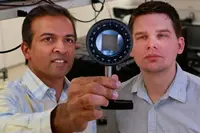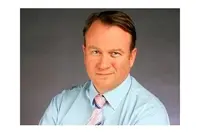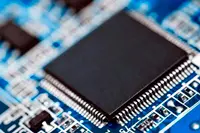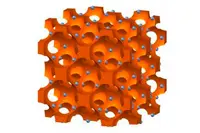Electronics News
Archive : 27 February 2015 год
 University of Utah engineers have discovered a new approach for designing filters capable of separating different frequencies in the terahertz spectrum. According to the team, the filter – which can be produced using an ink jet printer – could allow mobile phone users and Internet surfers to download data 1000 times faster than today.
University of Utah engineers have discovered a new approach for designing filters capable of separating different frequencies in the terahertz spectrum. According to the team, the filter – which can be produced using an ink jet printer – could allow mobile phone users and Internet surfers to download data 1000 times faster than today.
University of Utah engineers have discovered a new approach for designing filters capable of separating different frequencies in the terahertz spectrum. According to the team, the filter – which can be produced using an ink jet printer – could allow mobile phone users and Internet surfers to download data 1000 times faster than today.
Professor Ajay Nahata and graduate student Andrew Paulsen discovered that, by creating certain computer generated designs using MATLAB and ink jet printing them using a silver metal ink on a plastic sheet, they could create a filter that allows certain terahertz frequencies to pass through while blocking others. The dimensions and geometry of the printed design determines which frequencies can pass.
The researchers say their development is an important step in exploiting the terahertz spectrum commercially. If mobile phones on a 4G network can download data at 10 to 15Mbit/s, they believe terahertz technology can, potentially, send data back and forth at Tbit/s. Using filters in such a network will be vital, they say.
"Terahertz technology is something in which there is a lot of interest," said Prof Nahata. "I guarantee that people will come up with new ideas that can use all of that available bandwidth."
Author
Graham Pitcher
Source: www.newelectronics.co.uk
 Lindsley Ruth will take over as group chief executive of Electrocomponents with effect from 1 April 2015, replacing the incumbent Ian Mason.
Lindsley Ruth will take over as group chief executive of Electrocomponents with effect from 1 April 2015, replacing the incumbent Ian Mason.
Lindsley Ruth will take over as group chief executive of Electrocomponents with effect from 1 April 2015, replacing the incumbent Ian Mason.
Lindsley Ruth said: "I am excited about joining the team at Electrocomponents and look forward to leading the organisation to accelerate growth, improve profitability and set the business on track to create value."
He joins Electrocomponents – the parent company of RS Components – from Future Electronics, where he is currently executive vice president. Previously, he has worked with TTI and Solectron.
Electrocomponents chairman Peter Johnson, noted: "Lindsley has highly relevant international experience and an excellent track record in a successful global distribution business with many similarities to our own. He has consistently driven growth and performance and I look forward to working with him to grow our business and deliver value for our shareholders."
Author
Graham Pitcher
Source: www.newelectronics.co.uk
 Millimetre wave communications developer SiBeam has released the SB6501 and SB6510 UltraGig network processor and RF transceiver chipset. The IEEE802.11ad compliant chipset delivers up to 7Gbit/s in devices such as smartphones, tablets, ultrabooks, access points and wireless docks.
Millimetre wave communications developer SiBeam has released the SB6501 and SB6510 UltraGig network processor and RF transceiver chipset. The IEEE802.11ad compliant chipset delivers up to 7Gbit/s in devices such as smartphones, tablets, ultrabooks, access points and wireless docks.
UltraGig is said to take advantage of advanced beam forming technology and an antenna diversity architecture supporting single or dual-antenna arrays.
Antenna diversity, says the company, provides RF placement flexibility, while enhancing system RF robustness. Its small form factor supports a wide range of product designs and represents an optimized solution between power efficiency, bandwidth and cost.
"As consumer demand for wireless data and video continues to grow, 802.11ad in the 60GHz spectrum delivers the much needed network capacity, making it a viable extension to the congested 2.4GHz/5GHz Wi-Fi spectrum," said SiBeam's president Khurram Sheikh. "Our SB6501 and SB6510 UltraGig chipset expands our millimetre wave expertise and product portfolio to meet the demand for multi gigabit wireless data and video connectivity."
Author
Graham Pitcher
Source: www.newelectronics.co.uk
 Building on the four standards it published at electronica in November 2014, the Architects of Modern Power (AMP) consortium has announced a further standard aimed at establishing common mechanical and electrical specifications for the development of advanced power conversion technology for distributed power systems.
Building on the four standards it published at electronica in November 2014, the Architects of Modern Power (AMP) consortium has announced a further standard aimed at establishing common mechanical and electrical specifications for the development of advanced power conversion technology for distributed power systems.
Called teraAMP, the standard has been designed for non isolated digital point of load (POL) DC/DC converters and is said by the AMP group to extend the current range from 90 to 120A.
The consortium was unveiled in October 2014 (click here for more) by founder members CUI, Ericsson Power Modules and Murata Power Solutions. The three said the move was made for a number of reasons, including supply chain security, customer choice and to accelerate innovation.
Speaking on behalf of the group, Mark Adams from CUI said: "The teraAMP standard is the next step in high density, high complexity power design support. "As chip architectures continue to reduce and on board power requirements increase, it is imperative that the power industry keeps pace by providing high current density solutions at the point of load."
The teraAMP standard adds to the microAMP and megaAMP standards for digital POLs that covered 20 to 25A and 40 to 50A designs respectively.
AMP has also defined two standards for advanced bus DC/DC converters: ABC-ebAMP relates to advanced bus bricks measuring 58 x 23mm and ranging from 264 to 300W; while ABC-qbAMP covers quarter brick supplies with outputs ranging from 420 to 468W.
Products based on the teraAMP standard are expected to be announced at APEC 2015.
Author
Graham Pitcher
Source: www.newelectronics.co.uk
 In order to allow an electric vehicle to travel for hundreds of miles at a time, lithium-ion batteries will have to have to store more energy, but keep the same size. However, according to a researcher, this is a dilemma as, in order to hold enough energy to enable a car to drive for 500 miles before recharging, current lithium-ion batteries become too big or too expensive.
In order to allow an electric vehicle to travel for hundreds of miles at a time, lithium-ion batteries will have to have to store more energy, but keep the same size. However, according to a researcher, this is a dilemma as, in order to hold enough energy to enable a car to drive for 500 miles before recharging, current lithium-ion batteries become too big or too expensive.
Associate Professor of Chemistry at Boston College in the US, Dunwei Wang, has been developing materials that might one day enable the manufacture of new batteries that meet size and cost constraints.
Wang and a colleague from the University of Massachusetts Amherst has developed a way to stabilise carbon and believes this could pave the way to new battery performance standards.
Researchers pursuing a 'lithium-air' battery have focused on a chemical reaction of lithium and oxygen, but the materials involved have limited lives. Wang says this is due to the instability of carbon, an essential structural part of the battery's electrode.
"Carbon is used in every battery because it has low cost, light weight and conductivity," said Wang. "You can't just scrap it."
Wang's solution, in association with Assistant Professor of Chemical Engineering Wei Fan from Amherst, is called three dimensionally ordered mesoporous (3DOm) carbon.
Initial tests show a marked improvement in performance. "We demonstrated that a particular form of carbon can be used to support a new type of chemistry that allows for energy storage with the promise of five to 10 times more energy density than state of the art lithium-ion batteries," said Wang. "We see this as significantly improving the cyclability of the battery, which is a key issue."
Author
Graham Pitcher
Source: www.newelectronics.co.uk

